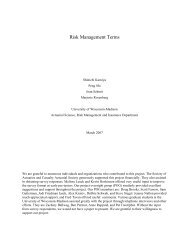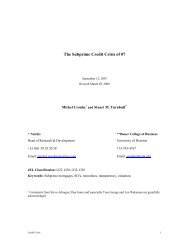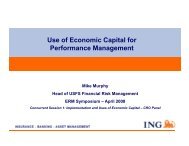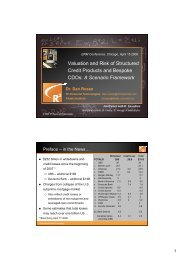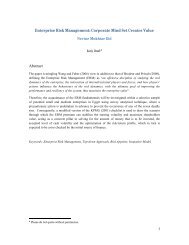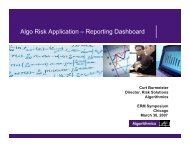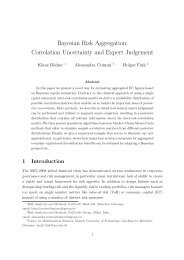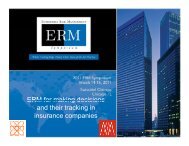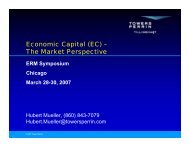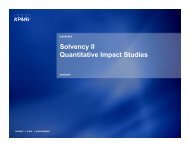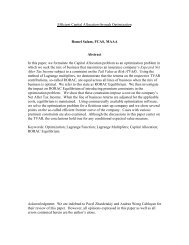An Empirical Map of Enterprise Risk Space for ... - ERM Symposium
An Empirical Map of Enterprise Risk Space for ... - ERM Symposium
An Empirical Map of Enterprise Risk Space for ... - ERM Symposium
Create successful ePaper yourself
Turn your PDF publications into a flip-book with our unique Google optimized e-Paper software.
Explanation and Illustration<br />
To illustrate better the objective <strong>of</strong> our study we created Figure 1 noted above, reproduced from<br />
Baran<strong>of</strong>f and Sager (2006). Figure 1 depicts our interpretation <strong>of</strong> the conventional wisdom about<br />
the structure <strong>of</strong> the risks and <strong>ERM</strong> tools <strong>of</strong> financial institutions, and particularly, life insurers. :<br />
(Part A) the space <strong>of</strong> risks, (Part B) the space <strong>of</strong> <strong>ERM</strong>, and (Part C) the interaction between the<br />
risks space in Part A and the <strong>ERM</strong> tools space in Part B.<br />
Part A depicts the risk space <strong>of</strong> life insurers in its <strong>for</strong>m as most commonly apprehended in<br />
current research (i.e. Baran<strong>of</strong>f and Sager, 2002 and 2003, Cummins and Sommer, 1996 and<br />
Shrieves and Dahl, 1992) and in practice. The enterprise risks <strong>of</strong> a life insurer originate from<br />
three broad activities in which life insurers engage: underwriting (product) risks that arise from<br />
selling insurance contracts and policies; asset risks that arise from investing premiums and other<br />
income; and operational risks from engaging in necessary and appropriate supporting activities<br />
as a business entity. Asset/liability matching is considered a major risk overlapping all three<br />
categories and is denoted as a major <strong>ERM</strong> tool.<br />
It is important to note, that the conventional wisdom does not regard these risks as mutually<br />
exclusive. Many risks overlap each other and have fuzzy boundaries. The full story <strong>of</strong> risks is too<br />
complex to portray in detail, given the limitations <strong>of</strong> schematics such as Figure 1.<br />
Part B is the space <strong>of</strong> the <strong>ERM</strong> tools in mitigating the risks described in Part A. This part utilizes<br />
tools discussed by the survey study <strong>of</strong> Santomero and Babbel (1997), RM tools discussed in<br />
Baran<strong>of</strong>f (2004) and many practical tools that can be proxied using accounting data. Again, as in<br />
Part A, <strong>ERM</strong> tools are categorized in three groups: <strong>for</strong> asset risk, <strong>for</strong> product risk and <strong>for</strong><br />
operational risks that flow from Part A. The same complexity that is emphasized <strong>for</strong> Part A is<br />
applicable to Part B.<br />
4



